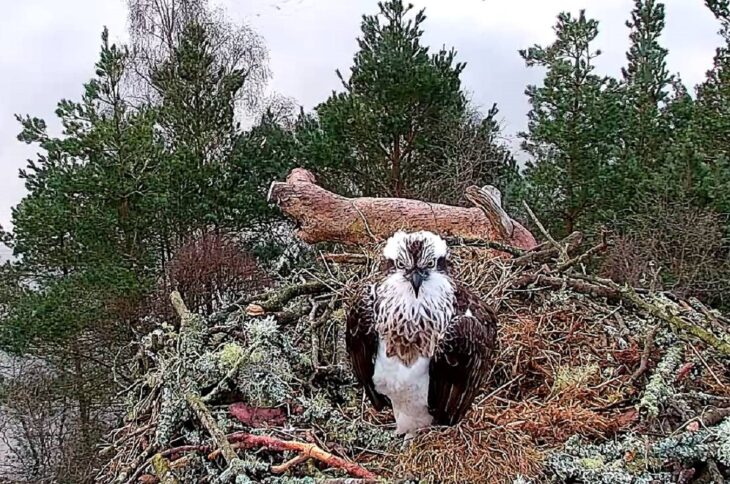How do migrating ospreys find their way south?
Loch of the Lowes has been an eventful place for the last few weeks. The sky has been busy with soaring ospreys and fishing activity has frequently disturbed the still waters of the loch. This is a special time of year, as we have been lucky to witness our two juveniles fledge the nest and join their parents in flight, learning from and practicing their adult behaviours. But this period is also rather short and sweet. Suddenly the busy nest we have watched over since March can begin to feel very empty.
Then, one day passes and we notice that the calls of our female NC0 are missing from the usual chorus, nor any remarks made of her quirky behaviourisms. After a few days it becomes clear that she has indeed departed with no grand farewell display, or even a long gaze into the camera.

You can’t help but feel a little bit sad. But for the team at Loch of the Lowes, reaching the end of a successful breeding season shows that the long hours spent watching over the nest was worthwhile, and fills us with pride. I would like to say a huge thanks to all Osprey Watch volunteers for their support in monitoring the wellbeing of our resident ospreys this season.
Scotland’s ospreys instinctively follow a well-flown path, taking a southerly route along the coastal margins of the UK, France, Spain and Portugal. This journey will most likely end in West Africa, although some ospreys are now spending the winter in the south of Spain and Portugal.
Unlike some other migratory birds which travel in groups, such as geese, ospreys fly solo. Without peers and parents to follow, they cannot memorise the routes taken by their parents as a means of navigating. This begs a question. How do juvenile ospreys make it to their wintering grounds?
How do ospreys navigate?
Numerous theories have been suggested, including the presence of a protein within osprey’s eyes which enables them to visualise the Earth’s magnetic field. This would be followed to warmer climates in the south, whilst hugging the coastline to stay within reach of feeding areas.
A process of ‘vector summation’ is also suggested, as a means of segmenting the journey into achievable distances. These segments are genetically inherent, meaning the knowledge of which direction to travel in during each flight step (and the number of steps) will be present since infanthood. This process is much more greatly relied on by juveniles taking their first migration, as they will not yet have the topographical memory needed to readjust their trajectory towards recognisable landmarks.
External factors such as wind drift can impact the orientation of ospreys, which can be detrimental to their success. Once off course it is not so simple to re-calibrate an internal GPS. Often osprey do not recover well from being blown off course. Depending on the direction of the wind they could end up over deserts – with no opportunities to find food and exposed to unexpected predators – or in vast expanses of ocean where the next land is nearer to South America than the fish abundant deltas of Senegal or The Gambia.
Even staying on course has its perils. For example crossing the Bay of Biscay, the massive gulf between France and Spain represents a great challenge. With favourable winds, this path can be taken in one long stint with the aim to continue down the Spanish coastline. But continuous flight across the Bay also runs the risk of draining energy levels, and being mobbed by seagulls along the way. This increases the risk of drowning before reaching the next resting place, and is an option better left to experienced birds.

What’s next for NC0?
NC0 may be a young adult but she is experienced enough to face the trials of migration and make it through in good condition. As a female bird she has more weight to carry, but she has been building up her fat reserves these past weeks while LM12 still supplies most of the fish for the young. Although, and perhaps unusually, in the last few weeks NC0 has also been bringing in a plentiful supply of large fish to the nest.
These fat reserves provide the energy needed to fuel long periods of flapping flight. This is particularly necessary when flying over water, where thermals are less frequent. Ospreys also stop off at resting points where rivers and estuaries provide the opportunity to fish. Hopefully, fair winds will carry NC0 and her family well, easing their flight by raising them up on thermals over land where they can conserve energy by gliding. NC0 will spend the winter in her territory until spring, when hopefully she will return to reclaim the nest at Loch of the Lowes as her breeding site for another season.
Helen Lancaster, SPO & Assistant Ranger
Help protect Scotland’s wildlife
Our work to save Scotland’s wildlife is made possible thanks to the generosity of our members and supporters.
Join today from just £3 a month to help protect the species you love.
Preface
Loch of the Lowes has been an eventful place for the last few weeks. The sky has been busy with soaring ospreys and fishing activity has frequently disturbed the still …
